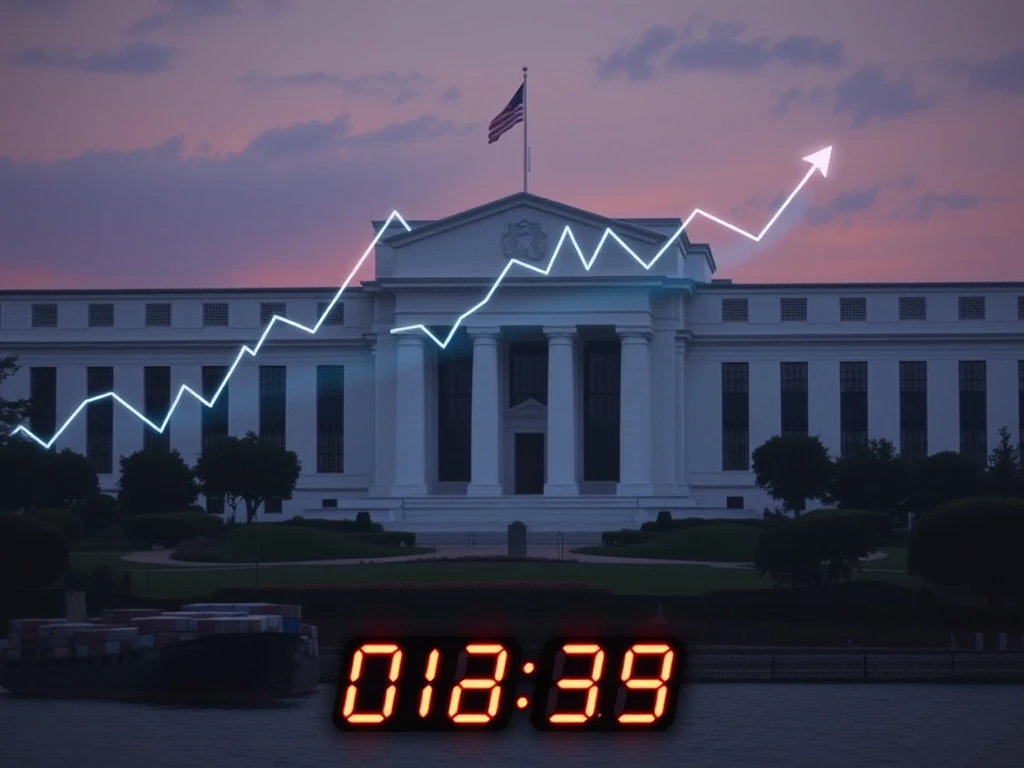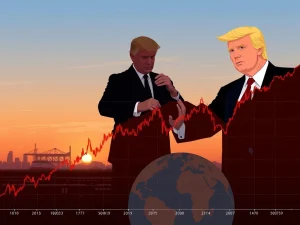Fed Interest Rate: Crucial Decisions Impacting Global Markets

Are you tracking the pulse of the global economy? For anyone invested in the dynamic world of cryptocurrencies, understanding the broader macroeconomic landscape is absolutely vital. This week brings a critical convergence of events, spearheaded by the Federal Reserve’s latest Fed interest rate decision, that could significantly shape market sentiment and, by extension, the crypto space.
Fed Interest Rate: Holding Steady Amidst Uncertainty?
The financial world is holding its breath as the Federal Reserve gears up for its July 31–August 1 meeting. The prevailing expectation is that the benchmark Fed interest rate will remain unchanged at 5.25%-5.5%. This decision reflects the Fed’s cautious approach, balancing persistent inflation signals against a cooling, yet resilient, labor market.
- The Stance: Officials are likely to “hold the line” for now, signaling a patient wait-and-see approach.
- Future Hints: The real focus will be on the accompanying policy statement and economic projections. Any subtle shifts in language could hint at future easing, particularly if upcoming data shows significant moderation.
- Market Reaction: A steady rate might be seen as a neutral outcome, but any hawkish or dovish surprises in the commentary could trigger volatility across all asset classes, including digital assets.
Unpacking Inflation: What Do the Numbers Mean?
The core PCE price index, the Federal Reserve’s preferred measure for inflation, is a key data point on the calendar. Its trajectory directly influences the Fed’s timeline for potential rate adjustments. Here’s what analysts are watching:
The forecast for June’s core PCE price index is a 0.3% month-on-month rise, a slight increase from previous months. A stronger-than-expected reading could reinforce the Fed’s cautious stance, potentially delaying any anticipated rate cuts later in the year. Conversely, a softer print would provide more room for the Fed to consider easing monetary policy. The delicate balance between price stability and economic growth is at play, and these inflation figures are crucial for market participants.
Nonfarm Payrolls: Gauging the Labor Market’s Health
The U.S. labor market data, particularly the nonfarm payrolls report, provides another critical piece of the economic puzzle. Scheduled for August 2, this report will offer fresh insights into employment trends and their potential impact on consumer spending and, ultimately, inflation.
Analysts project a modest gain of 85,000 jobs. This figure would suggest a continued cooling of the labor market without indicating a sharp downturn that would necessitate immediate, aggressive policy action from the Fed. However, caution is advised due to potential data volatility and revisions to prior estimates. A stronger outcome could signal persistent inflationary pressures, while a weaker report might accelerate expectations for a 50-basis-point rate cut by year-end. The ADP private employment report, due July 31, offers an early, albeit unofficial, glimpse into this crucial sector before the official nonfarm payrolls release.
US-China Trade Talks: A Geopolitical Wildcard
Beyond the domestic economic indicators, the intricate dance of US-China trade relations adds a significant layer of geopolitical uncertainty. With tariff deadlines looming, markets are bracing for potential retaliatory measures that could disrupt global supply chains and dampen economic sentiment.
While a comprehensive resolution to long-standing disputes is unlikely in the short term, any incremental progress or de-escalation of rhetoric could provide a much-needed boost to market confidence. Conversely, heightened tensions could exert downward pressure on global growth forecasts and further complicate the Fed’s monetary policy decisions. The U.S. dollar has already shown sensitivity to these trade-related risks, reflecting how intertwined global politics are with economic stability.
Beyond Rates: The Broader Monetary Policy Picture
While the Fed interest rate decision is paramount, several other economic releases contribute to the overall monetary policy outlook and market sentiment. These include:
- Initial Jobless Claims: Providing real-time insight into labor market health.
- ISM Manufacturing PMI: An indicator of manufacturing sector activity.
- University of Michigan Consumer Sentiment Index: Reflecting consumer confidence, a key driver of economic activity.
- Q2 GDP Figures: Expected to show 1.2% annualized growth, offering a broader context of economic performance.
- Stablecoin Regulation: Hong Kong’s upcoming stablecoin regulation release on Friday also highlights the growing intersection of traditional finance and digital assets.
Investor positioning across various asset classes, from gold struggling to hold above $3,400 per ounce, reflects heightened sensitivity to these unfolding developments. Each piece of data, while seemingly small, contributes to the larger narrative shaping central bank decisions and global market trends.
What Does This Mean for You?
The upcoming week is packed with high-stakes economic data and policy decisions that will undoubtedly influence market volatility. For cryptocurrency investors, these macroeconomic shifts are crucial. A more hawkish Fed or escalating trade tensions could create headwinds for risk assets, while signs of moderating inflation and a stable labor market might pave the way for a more supportive environment. Staying informed and understanding the interplay of these factors is key to navigating the evolving economic landscape.
Frequently Asked Questions (FAQs)
Q1: Why is the Federal Reserve’s interest rate decision so important?
The Federal Reserve’s interest rate decision directly influences borrowing costs for consumers and businesses, impacting everything from mortgages to corporate investments. It also affects the value of the U.S. dollar and, consequently, global trade and asset prices, including cryptocurrencies, as it dictates the broader economic liquidity and risk appetite.
Q2: What is Core PCE inflation, and why does the Fed prioritize it?
Core Personal Consumption Expenditures (PCE) is the Fed’s preferred inflation gauge because it tracks changes in the prices of goods and services purchased by consumers, excluding volatile food and energy prices. This provides a clearer picture of underlying inflation trends, which is crucial for long-term monetary policy decisions.
Q3: How do nonfarm payrolls impact the Fed’s decisions?
The nonfarm payrolls report indicates the health of the U.S. labor market. Strong job growth can signal a robust economy, potentially leading to higher wages and inflation, which might prompt the Fed to maintain higher interest rates. Conversely, a significant slowdown could signal economic weakness, potentially leading to rate cuts.
Q4: What role do US-China trade talks play in the economic outlook?
US-China trade relations are a major geopolitical and economic factor. Tensions or new tariffs can disrupt global supply chains, increase costs, and reduce international trade, negatively impacting corporate earnings and overall economic growth. This uncertainty can lead to market volatility and influence central bank policies.
Q5: Will the Fed’s decision directly affect cryptocurrency prices?
While the Fed’s decision doesn’t directly target cryptocurrencies, it significantly influences the broader financial market’s risk sentiment. A more restrictive monetary policy (higher rates) generally makes traditional safe-haven assets more attractive and can lead investors to pull away from riskier assets like crypto. Conversely, easing policies can make risk assets more appealing.








